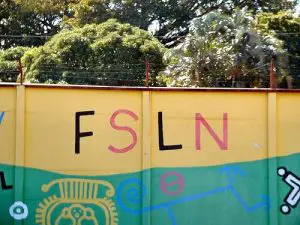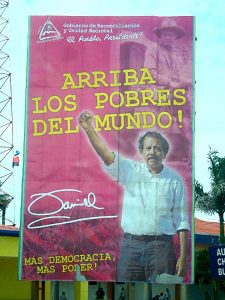TCRN Staff: Mr. Opinion.
The Sandinista National Liberation Front (Spanish: Frente Sandinista de Liberación Nacional, or FSLN) is a socialist political party in Nicaragua. Its members call themselves Sandinistas. The party is named after Augusto César Sandino who led the Nicaraguan resistance against the United States occupation of Nicaragua that began in 1912 with a full-scale invasion.
The 1912 American military interventions in Nicaragua were designed to prevent the construction of the Nicaraguan Canal by any nation but the United States. The occupation ended as Augusto César Sandino, a Nicaraguan revolutionary, led guerrilla armies against American troops; these battles were the most remembered conflict of the “Banana Wars”. In 1933, a withdrawal was ordered because the Great Depression made it too costly to maintain.
In the following decades the FSLN continued to structure its political presence.
In 1979, the FSLN overthrew the ruling party and established a revolutionary government in its place. The Sandinistas ruled Nicaragua from 1979 to 1990 following their seizure of power. The FSLN took exclusive power in March 1981. They instituted a policy of mass literacy, devoted significant resources to health care, and promoted gender equality. In 1981, contra militias, known as Contras, began to resist the Sandinistas Junta and were supported by the American Central Intelligence Agency. In the mid-1980s, the Sandinistas electoral victory caused the Contras to continue their attacks on state and civilian targets, and this continued until 1989. The FSLN lost elections in 1990 to Violeta Barrios de Chamorro, after revising the constitution in 1987 and after years of resisting the United States-supported Contras, but they retained a plurality of seats in the legislature.
Ortega’s unexpected return to power in 2007 promised reconciliation. He is considered to be the most divisive figure in Nicaragua’s recent history. Ortega’s effort is focused on remaining in power, even if it means sacrificing the newly developed democracy that the Sandinista Revolution helped plant 20 years ago. After being voted out of power in 1990 following a decade of U.S.-sponsored counterrevolutionary war, it took Ortega 16 years and three elections to return to the presidency in 2007.
Ortega began a series of political moves, such as aligning himself the unpopular Hugo Chavez. As well, Ortega pledged closer ties with Iranian President Mahmoud Ahmadinejad, in 2007.
Ortega’s attempt to re-write the constitution also caused an outcry. “The principal goal of Ortega is to stay in power and he is going to do everything possible to do so,” Ortega’s former vice president, Sergio Ramirez, said in early 2008.
Ortega’s action over the past couple of years has caused concern, both inside and outside Nicaragua. The Nicaraguan-American Chamber of Commerce (AMCHAM), the country’s leading tourism chamber, expressed exasperation, blaming the certain Sandinista elements for “continuously destroying the work we have done to improve our international image.” Even the Organization of American States (OAS) expressed concern about the downward spiraling situation in Nicaragua. A group of Nicaraguans that Ortega seems to have successfully united, are the former civil war combatants of the 1980s, from both sides. Former Sandinista guerrillas and contra fighters have started to find common ground by uniting against Ortega’s efforts to kill or destroy democracy and circumvent constitutional electoral term limits in order to get himself reelected in 2011.
One group, calling themselves the Movement Against Reelection and Fraud have a new slogan “If there is reelection, there will be insurrection.” Ex-contra leaders are also warning that there will be a new revolution if Ortega consolidates a “totalitarian regime.” Both groups see Ortega as being a puppet of Hugo Chavez.
Nicaragua’s Supreme Court judges appointed by the Sandinistas last year exempted Ortega from that law even though the constitution prohibits consecutive presidential terms. Ortega currently has the lowest approval rating of any president in Latin America and Nicaragua’s fractured political opposition is still losing ground to the regimes continued attack against the country’s delicate constitutional democracy. That situation is driving ex-Sandinista and contra militants to take matters into their own hands.
Henry “Modesto” Ruiz, a Sandinista guerrilla hero, who ran the first Sandinista government, says that they are determined to prevent a return to violence now, warning that time is running out. As well, the leaders of the contra resistance are reemerging. “We will not allow another criminal and genocidal Sandinista dictatorship like the one the Nicaraguan people lived under in the 1980s…” Former contra commander Luis “Comandante Jhonson” Fley has been quoted as saying. “…if Ortega gets reelected, the strategy changes. We can’t allow that to happen.”
In many circles, the current Nicaragua-Costa Rica dispute over the rights to the mouth of the San Juan river is seen as a ruse to distract the people of Nicaragua (and the international community) from Ortega’s internal power play for a totalitarian regime, and give the people of Nicaragua a cause to united against the enemy (Costa Rica) that is portrayed as attempting to annex a piece of their country.
In light of Ortega’s true mission of a totalitarian government, the San Juan river dispute seems like a minor issue in comparison. If Ortega is allowed to achieve his goals, it will have long lasting and dangerous effects for rest of the Central American countries.


